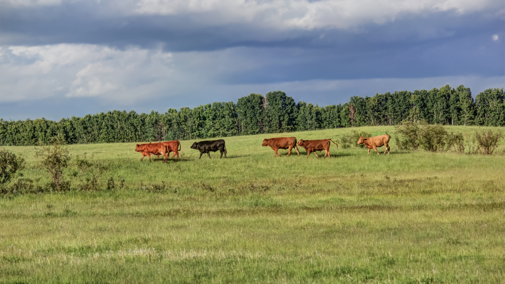Grazing with the Weather
Precipitation and temperature play major roles in pasture productivity, and knowing how to adjust grazing to match current conditions is key. Are you shifting your management to meet pasture conditions?
Stocking and grazing management are not static things. When production is limited, especially during a drought period, stretching forage resources is a high priority. In contrast, during wet years, grass growth can get ahead of our grazing rotation and lose quality.
By this point in the year, our pastures have produced the vast majority of forage that we will get. Using temporary electric fence to cross fence can increase utilization, slowing down a grazing rotation and stretching forage considerably during dry weather.
This is especially true when plants become dormant due to lack of precipitation or heat. Typically, utilization seeks to balance animal demand and plant health, but taking more of a dormant plant without damaging the crown has little impact on overall plant health.
On the flip side, grass that is getting tall and lanky ahead of a grazing rotation could benefit from flash grazing. Moving animals on and off quick can help keep plants from getting overly mature. Keep up this fast pace while growth is rapid. Once growth slows, then the rotation can slow down as well.
Speeding up grazing when things are wet and slowing down during dry times is a good rule of thumb to use as we adjust to the weather Mother Nature throws our way. Doing so can help you find the perfect balance for your pasture and animal health.
Summer Heat and Forage Growth
When summer temperature stress increases, how do these higher temperatures potentially impact our pasture and forage plants? Range plants are either classified as cool-season or warm-season species, and cool-season plants are far more impacted by hot temperatures compared to warm-season. However, every plant species has a specific temperature range in which it maintains growth.
When it gets hot (90-plus degrees), cool-season plants such as bromegrass, orchardgrass, fescues, needlegrasses and wheatgrasses all struggle and will have a very slow growth rate, even if there is plenty of moisture. When it is very dry, these same cool-season grasses may completely stop growing and move into a summer dormancy state.
Warm-season grasses are just the opposite. Millet, sudangrass, sorghums, native grasses such as bluestems, gramas, switchgrass and other warm-season grasses thrive when the temperature extend to 90 degrees. Their metabolism runs at peak efficiency when it is hot, so they grow rapidly while maintaining reasonable forage quality and good root growth. However, drought conditions can cause summer seeded annual grasses to accumulate nitrates, which can negatively impact cattle consuming the forage.
As you manage forage grazing or haying during heat stress periods, allow plants longer recovery periods before the next grazing. Also, expect feed nutritional values and/or animal gains to be lower when plants are under heat stress.
Bottomline is that high summer temperatures require adjustment to limit hot weather stress with both cool-season and warm-season ranges and pastures.
Sub-irrigated Meadow Hay Harvest
July traditionally means the beginning of the haying season for Sandhills sub-irrigated meadows. A key point related to the quality of meadow hay is harvest date. Crude protein and energy concentration decline as plants become stemmy and mature. As this happens, the types of livestock that can be fed that hay with little or no supplements become more limited.
A good practice can be to record harvest dates for different meadow fields. Quality of hay cut in early July could vary significantly compared to hay cut in late July or August. Including notes if hay was impacted by rain before baling can also be useful. This information, along with hay tests, can be useful when making hay feeding decisions this winter and next spring. Also remember that earlier meadow harvest will provide a longer regrowth period and extra growth for fall grazing.
Within some meadows, there can be variation in hay quality depending on plant species that are present. Sedges and rushes are most common in the wettest and lower parts of meadows and these species are lower in quality compared to grasses.
The extra rain received in parts of Nebraska this year has been mostly welcome. But excess rain can make some meadows impossible to even get in to cut the hay. When hay is in demand, waiting until the ground dries and firms up enough to drive haying equipment over it is an option, but the quality of this late cut hay will be lower.

